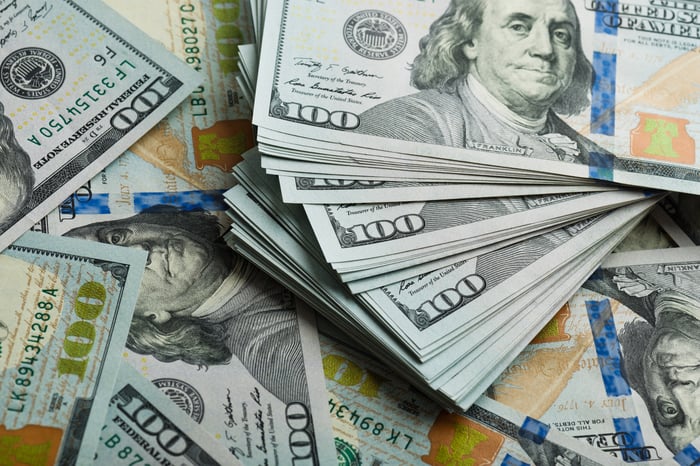Many investors are familiar with valuation metrics like price-to-earnings and price-to-sales ratios, and those certainly have their place in helping to evaluate companies on a relative basis. But they don't provide much insight into how efficiently a business operates or how effectively management spends cash.
That's where the return on invested capital (ROIC) metric comes in. It measures the profit on every dollar invested, whether it's used to fund operations or purchase assets, or returned to shareholders in the form of stock buybacks or dividends. Thus, it can help investors determine which management teams of which companies are better at allocating capital.
Based on earnings results over the past several years, the teams at Apple (AAPL 1.35%) and Mastercard (MA 0.63%) have this down to a science.

Image source: Getty Images.
Mastercard's ROIC was 36% in 2020
Mastercard is an excellent example of a well-managed business. At the end of fiscal 2020, its ROIC was an incredible 36%. Put another way, it produced $0.36 in cash for every $1 invested in its business.
Part of Mastercard's efficiency stems from its business model in general. A large portion of the financial giant's expenses are unrelated to its operational performance. For instance, if you open a credit card account tomorrow, the company won't need to build new data centers or buy new servers to support the additional burden on its network. It has already made the upfront investments and has the necessary infrastructure in place.
Businesses like Mastercard have high fixed costs, and as these businesses scale, their operating margins tend to expand. By contrast, retailers typically have high variable costs. If you go buy a shirt from your favorite store, no one else can buy that shirt. It's gone. In order to sell another shirt, the company will have to spend money to make or buy one. In other words, many of the company's costs vary based on the performance of its business.
However, Mastercard's business model isn't the only reason it achieves such impressive efficiency. Visa has a virtually identical business, but its ROIC is only 19%. That's still a pretty good number, but there's no question that Mastercard uses its capital more efficiently.
Ultimately, there is no single reason why that's the case -- it's a combination of many different capital allocation decisions. For instance, Mastercard has significantly less debt than Visa and has far fewer assets on its balance sheet. Both of those differences result in Mastercard having less invested capital, which effectively boosts ROIC.
Regardless of the explanation, here's the bottom line: Visa generates $0.19 on every $1, while Mastercard generates nearly twice as much.
Apple's ROIC was 34% in Q1 of 2021
Apple is another example of an efficient business. As of the most recent quarter, its ROIC was 34%. That outstrips all of its big-tech peers. For instance, Alphabet (GOOG -0.27%) (GOOGL -0.22%) and Amazon (AMZN 0.61%) ended their fiscal 2020s with ROICs of 19% and 20%, respectively.
In this case, Apple's 25% operating margin is a key differentiator. By comparison, Alphabet and Amazon had operating margins of 23% and 6%, respectively, in 2020.
Additionally, Alphabet and Amazon also have much more capital tied up in property, plants, and equipment (PPE) -- $85 billion and $113 billion, respectively. Apple, on the other hand, has just $37 billion in PPE on its balance sheet.
Again, Apple is clearly the more efficient business. The company generates $0.34 in profit on every $1 invested, while Alphabet generates $0.19 and Amazon generates $0.20 on every invested dollar.
A final word
No investment should be made based solely on any single valuation metric. Visa, for example, has been an excellent investment over the last decade, despite having a lower ROIC than Mastercard. The same is true of Alphabet and Amazon relative to Apple.
That being said, efficiency matters. Why spend $10 when you could accomplish the same thing with $5? So if you're trying to decide how much of your own capital to allocate to any particular investment, take a look at the company's ROIC. It might give you some useful perspective on how efficiently its management team is running the business.





